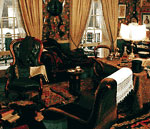On the Trail, Over the Falls
The sweetness of this village probably emanates from the rows and rows of meringue shops lining the streets. Locals claim meringue originated from the area, thus the name Meiringen. But other than this dessert and the abounding scenery, the village thrives out of paying homage to Holmes. Travelers won’t miss numerous signs with references to Holmes or his creator. Meiringen has its own Baker Street and Conan Doyle Place signs—the finish of which evokes London. Right beside the hotel is a Sherlock Holmes Museum, and in it is the world’s first authentic replica of the living room in 221B Baker Street. Unlike its counterpart in London, where the visitor is free to move about and touch the displays, the meticulous construction of the living room in Meiringen makes preservation essential, with visitors able to see it only through a glass wall. All of the displays are based on how Conan Doyle had described them in the stories, down to the tiniest detail. The museum is located in the basement of an old English church. A climb down the stairs reveals some items displayed in glass cases, a good deal of Holmesiana either donated or loaned by members of societies, such as the Sherlock Holmes Society of London. Outside the church is a statue of Holmes sculpted by John Doubleday with the heading “Sherlock Holmes Honorary Citizen of Meiringen.” There are symbols on the statue—sixty clues to each of the four novels and fifty-six stories that would test any Holmes devotee’s powers of observation. The village is best explored on foot, which makes for tired feet. To rest, I sat down in the square facing the Sherlock Holmes Museum, and I got that feeling of not wanting to be anywhere else.
During winter, Reichenbach Falls is inaccessible and, well, frozen. There is a road right on top of the highest fall that seems accessible by car, but the more exciting way to visit is from Meiringen on foot, on the steeply wooded path, re-enacting the journey Holmes and Watson took. There is also a funicular railway up to the lowest falls, and from there hikers trek up to the highest waterfall.
Despite efforts to enjoy the Alpine village and the breathtaking view of the mountains, I imagine Holmes always on guard, watching the faces of other tourists carefully, anxious that one of them might be the dark image of Moriarty. This worry must have heightened at the sight of Reichenbach Falls. Such a reward it is to view the falls after a long hike, but visitors can’t brush aside the fear. To eradicate the famous detective, Conan Doyle could have thought of monsters, savage hounds, or even something related to his beliefs in spiritualism. But there is something about Reichenbach Falls, which, even to the ordinary visitor, raises alarm. Standing on the bridge that looks altogether safe below the highest fall gives that uneasy feeling. There is an overwhelming sense of danger that if one was unlucky enough to lose balance and fall, there is no way he or she can be saved from that powerful water below. As clever and invincible Holmes and Moriarty might look to us fanatics, perhaps the power of nature was the only force that could have matched the great minds of these two.
Watson described it in the story:
It is indeed, a fearful place. The torrent, swollen by the melting snow, plunges into a tremendous abyss, from which the spray rolls up like the smoke from a burning house.
Once at the top there are signs pointing back to Meiringen and also to the ledge of the fictional struggle between Holmes and Moriarty, which can be reached by walking the path down the hill on the other side of the falls. I would say the hike to the falls must have been easier than the path Holmes and Watson or even Conan Doyle himself had taken. But while there are tourist-friendly, properly cemented steps climbing up to the falls, the path to the memorial plaque, even with the obvious trail, is slippery and steep and must be unchanged since the last century.
Conan Doyle must have had several ideas as to the end of Sherlock Holmes, so why Reichenbach? Whatever it was that enchanted him about the place, it was surely a piece of good fortune for all of Meiringen, securing their tourism income and giving them a spot on the literary map. It is a must for every Sherlock Holmes enthusiast to make a pilgrimage there.
Any modern reader can understand the feeling of grief when reading that last paragraph of “The Final Problem.” Perhaps it was more heartbreaking for those who followed through the stories in real time in The Strand magazine. Today, one could just pick up The Return of Sherlock Holmes and be grateful that Conan Doyle had changed his mind. But then again, even if he hadn’t, Holmes and Watson are timeless, coming back to life on whichever page the reader chooses to start.










